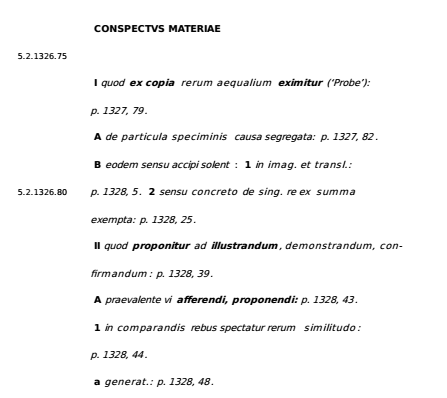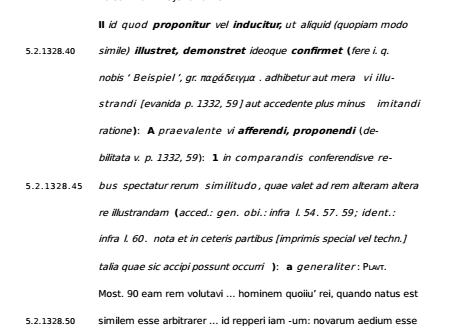About a year ago, we started a series of posts on the Thesaurus Linguae Graecae, or TLG. For various reasons, this series was never finished. But we’re here to help budding philologists with a companion piece for the TLG’s Latin pseudo-cousin, the Thesaurus Linguae Latinae (TLL). The TLL and the TLG are not run by the same group of scholars, and there are substantial differences in the way that each tool approaches the semiotics of its chosen language. From my perspective, it can be simplified into the question of format (1). The TLG is a digital product, albeit a product of a nascent digital age. The TLL is a paper product, and it doesn’t seem to change that much when transitioned to a digital medium. For you, the user, this basically means ‘expect a lot of scrolling’.
As we mentioned in the TLG entries, the TLG has been digital for a long time (and even has its own foundation myth). The TLL is only newly digital, and in many ways still clings to its paper foundations. For example, the volumes are not finished; currently they stop partway through the letter R. The offices of the TLL famously contain thousands of entry slips, much like a card catalogue, with the relevant information (and sometimes much more) written on them by hand. The project is a research project as well as a reference tool; if you are interested, the SCS offers a graduate/postdoctoral fellowship every year.
TLL entries include Latin from the earliest texts to the Middle Ages, as well as inscriptions, papyri, and so on. Generally speaking, this range is broader than other Latin dictionaries (including the standards, such as the OLD and the Lewis and Short), and is also broader than other online text repositories, such as PHI. So it is a safer choice when you need to be comprehensive, provided that the word you’re interested in is earlier in the alphabet than RA-. The TLL is available in paper and digital; generally either one is only purchased by departments with a graduate program. The digital version can be browsed for free, but is subscription-only.
Every TLL entry contains three major parts. First, a list of a forms (including spelling variants); second, an index of usage (‘conspectus’); and finally, a detailed list of every occurrence in Latin of the word, in all cases, according to the conspectus. We’ve chosen the fairly common word exemplum as our example (ha ha?). Warning to the wise: the entry is 53 pages long.
TIP: the hard copy TLL contains columns. It may be less daunting! But entries can still be hefty. If you have access to the online TLL, it’s better to use it (we’ll explain why below).

This actually looks a lot scarier than it is. This is Part 1 of the TLL entry: the list of known declined (or conjugated) forms of a word, including spelling variants. The grammatical information is provided in Latin — this is not a tool for newbies. If you look on the first line of the entry, you can see that exemplum is typically a neuter (n.) noun, but occasionally appears as a masculine (gen. masc.) noun: for example, in the Latin translation of 2 Maccabees. Similarly, the accepted (‘standard’) spelling of exemplum begins e-x-e-m, but epigraphic evidence suggests that many Romans spelled it (scribitur) with an additional s– : for example, in CIL 6.10515. Finally, in brackets on the first line of the entry, you can see the word’s etymology; in the case of exemplum, it comes from eximere.
If you are planning to cite this information, pay attention to the numbers in the left-hand column. They explain where you are in reference to the hard-copy version of the TLL. Because the TLL is in many ways a dictionary-encyclopedia, you’ll need the first three numbers: 5 (volume), 2 (part; part 1 is the letter d), 1326 (page). The last number, 45, is the line number of the page, and will help immensely in navigating the digital version.
If you’re concerned more with what the word means than what it looks like, part 1 isn’t going to be that interesting to you. You can skip straight to the conspectus, which is arranged in a hierarchical outline of different uses of your word.

This is the part that deals with usage throughout antiquity. It’s useful because it includes material that is later than standard dictionaries (like Lewis and Short), and because it provides full examples of that usage. Because the entries are arranged hierarchically, they can be dizzying to follow, so we’re going to take this step-by-step.
For each section under ‘conspectus‘ (I, II, III, etc.), there’s a Latin-Latin definition that covers every single known use of the word, in all cases, up to the time when that fascicle was published (2). Those start out being just the definitions, and that’s where you want to look to see if exemplum is known to mean what you want it to mean (e.g. “exemplum, figura rhetorica” vs. “exemplum in historiis” — I made those categories up because they are simpler than the actual TLL). Each broad-brush category is then subdivided into categories, and those subdvisions are frequently subdivided further. So, taking a closer look at II, all usages in two are more closely related to each other than usages in I or III are related to them. But the meanings clustered under IIA are, again, more closely related to each other than the meanings under IIB are related to IIA. You can use the outline to create a network of interrelated meanings, or a semantic web of words.
Note that the TLL knows that its entries are long. If you take a look at the conspectus and decide that you’re really only interested in IIA, you can skip all the way down (using the numbers in the left margin) to 5.2.1328.43.
Let’s say you did that. Here’s the beginning of your entry:

You can see that the beginnings of the entries echo the conspectus. There are some more traditional ‘dictionary’ aspects added here (a German translation, since the TLL is based in Munich, as well as a Greek translation), but the most important part comes deeper into the entry. Once you’ve gotten as specific as you can get, at II.A.1.a, you start to get concrete examples of that exact semantic use in chronological order. So our first example comes from Plautus’ Mostellaria.
If you take a quick skim through the text, you’ll notice something strange: no exemplum! That’s because the entry word is shortened to just its case ending. So on the last line, the Plautine text reads id repperi iam exemplum (not -um). In an entry this long, space is tight!
That’s the TLL in a nutshell: basically, the ‘conspectus‘ is like an index, and you use the bold parts of the rest of the entry to navigate — either using the actual numbers in the left-hand column, or using the outline numerals as if they were page numbers. Important note: when you cite the TLL, you cite the conspectus. So our chosen entry is correctly cited as “TLL s.v. exemplum, II.A.1.a” (it would also be correct without periods), not 5.2.1328.48-50. Those numbers are for your reference, not the rest of the world’s.
The TLL, as I mentioned at the start, is an advanced tool. It’s primarily Latin-only (definitely not English). It’s dense. It’s focused primarily on semantics, which means the often nuanced distinctions between word meanings in different times, places, circumstances, and situations. If you are an undergrad, you are probably never going to need this tool. If you are an MA student, you might not need this tool. If you’re a PhD student, you may find it very useful.
When would you use the TLL? Primarily, when you are trying to make an argument about the meaning of a given word in a specific context. Sometimes, these definitions are distinct enough to be obvious (e.g., I: something that is separated out from the crowd; II, something used to prove a point). But this won’t always be the case, and the deeper into the entry you go, the more similar these definitions will become. If we look at II.A.1.2.a-b, we can see that the differences between the entries are minimal:

II.A.1.2 in general covers exemplum as a teaching tool, and (a) offers general cases, while (b) offers specific types of teaching/learning environments (namely, rhetorical and grammatical schools). If you are making a detailed argument about what exemplum means in a given context, these rich examples can help you prove your point.
In general, the TLL is friendlier to flipping than scrolling, and if you are using the online version, you may want to keep the conspectus available in a different window for reference. Otherwise, be careful to note the sections that you’re interested in, and use the left-hand numbers for navigation — it’s easy to get lost in here!
(1) This judgment comes with the caveat that we here at the Library of Antiquity use the hard copy TLL. We were graciously given access to the exemplum entry by a reader.
(2) The online TLL incorporates updates, but since we use the paper version, we’re not sure how that works. If anyone in the audience does, please leave a comment!
~J.

[…] times, we looked only at the hard copy editions that were available. As we’ve noted before, digital isn’t always better. But often, digital editions have advantages over the printed […]
LikeLike